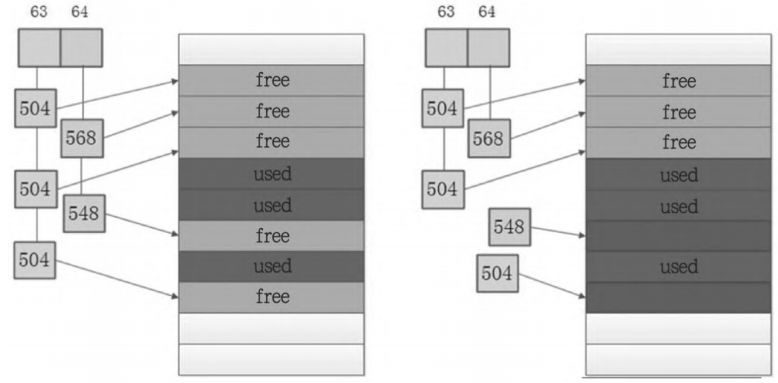文章目录
- 一、网络结构
- 1.1第一种block结构
- 1.2第二种block结构
- 1.3特征图融合
- 1.4损失函数
- 1.5总体网络架构
- 1.6代码汇总
- 1.7普通残差块与RSU对比
- 二、代码复现
参考论文:U2-Net: Going deeper with nested U-structure for salient object detection
这篇文章基于显著目标检测任务提出,显著目标检测是指将图像中最吸引人的目标或者区域分割出来,因此只有前景和背景两个类别,相当于语义分割中的二分类任务。例如,下图中展示了三张图片进行显著目标检测后的结果:

其中,白色区域代表前景 ,即最吸引人的目标或区域,而黑色区域代表背景 。
一、网络结构
U
2
−
N
e
t
U^2-Net
U2−Net网络基于
U
N
e
t
UNet
UNet网络设计而来。事实上,该网络的整体结构与
U
N
e
t
UNet
UNet网络几乎相同,但所使用的上采样、下采样模块变成了小型的
U
N
e
t
UNet
UNet网络,即,
U
2
N
e
t
U^2Net
U2Net本质上是
U
N
e
t
UNet
UNet网络的嵌套。而
U
2
−
N
e
t
U^2-Net
U2−Net网络的核心就是这些作为模块的小型
U
N
e
t
UNet
UNet网络,并将其起名为
R
e
S
i
d
u
a
l
U
−
b
l
o
c
k
(
R
S
U
,残差
U
块
)
ReSidual U-block(RSU,残差U块)
ReSidualU−block(RSU,残差U块)。网络结构如下:

这些模块其实可以分为两种,
E
n
c
o
d
e
r
1
E
n
c
o
d
e
r
4
、
D
e
c
o
d
e
r
1
D
e
c
o
d
e
r
4
Encoder1~Encoder4、Decoder1~Decoder4
Encoder1 Encoder4、Decoder1 Decoder4采用的是同一种结构的残差块,只不过深度不同,而Encoder5、Encoder6、Decoder5 采用的是另一种结构的残差块。整体流程可概况为:
- Encoder阶段:每通过一个模块后都会下采样两倍,使用的是
torch.nn.MaxPool2d。 - Decoder阶段:每通过一个模块后都会上采用两倍,使用的是
torch.nn.functional.interpolate()。 - 跳跃链接:与 U N e t UNet UNet网络思路相同,将编码器的输出与解码器输出的特征图进行拼接,最后得到分割后的图像。
1.1第一种block结构
论文中给出了常见的四种特征提取模块(图
(
a
)
−
(
d
)
(a)-(d)
(a)−(d)),以及提出的RSU模块(图
(
e
)
(e)
(e)):

- PLN模块:常规网络特征提取模块,包含卷积、归一化、ReLU激活函数三种计算。
- RES模块:残差块,增加了残差连接。
- DSE模块:特征图融合。
- INC模块:特征图融合。
而图
(
e
)
(e)
(e)即为本文提出的新型残差块
R
S
U
−
L
RSU-L
RSU−L,其中,L代表RSU的深度,论文中给出的是深度为7的RSU,即
R
S
U
−
7
RSU-7
RSU−7。该结构图的真实结构如下图所示:

回到
U
2
−
N
e
t
U^2-Net
U2−Net结构,该RSU的使用场景有:
- Encoder1 和 Decoder1 采用的是 RSU-7 结构。
- Encoder2 和 Decoder2 采用的是 RSU-6 结构。
- Encoder3 和 Decoder3 采用的是 RSU-5 结构。
- Encoder4 和 Decoder4 采用的是 RSU-4 结构。
可见,相邻 block 相差一次下采样和一次上采样,例如 RSU-6 相比于 RSU-7 少了一个下采样卷积和上采样卷积部分,RSU-7 是下采样 32 倍和上采样 32 倍,RSU-6 是下采样 16 倍和上采样 16 倍。代码实现如下:
import torch
import torch.nn as nn
from torchvision import models
import torch.nn.functional as F
class REBNCONV(nn.Module): #实现conv2d+BN+ReLU操作
def __init__(self,in_ch=3,out_ch=3,dirate=1):
super(REBNCONV,self).__init__()
# dilation用于实现空洞卷积
self.conv_s1 = nn.Conv2d(in_ch,out_ch,3,padding=1*dirate,dilation=1*dirate)
self.bn_s1 = nn.BatchNorm2d(out_ch)
self.relu_s1 = nn.ReLU(inplace=True)
def forward(self,x):
hx = x
xout = self.relu_s1(self.bn_s1(self.conv_s1(hx)))
return xout
def _upsample_like(src,tar):
src = F.interpolate(src,size=tar.shape[2:],mode='bilinear',align_corners=True)
return src
### RSU-7 ###
class RSU7(nn.Module):#UNet07DRES(nn.Module): #En_1
def __init__(self, in_ch=3, mid_ch=12, out_ch=3):
super(RSU7,self).__init__()
self.rebnconvin = REBNCONV(in_ch,out_ch,dirate=1) #CBR1
self.rebnconv1 = REBNCONV(out_ch,mid_ch,dirate=1) #CBR2
self.pool1 = nn.MaxPool2d(2,stride=2,ceil_mode=True)
self.rebnconv2 = REBNCONV(mid_ch,mid_ch,dirate=1)
self.pool2 = nn.MaxPool2d(2,stride=2,ceil_mode=True)
self.rebnconv3 = REBNCONV(mid_ch,mid_ch,dirate=1)
self.pool3 = nn.MaxPool2d(2,stride=2,ceil_mode=True)
self.rebnconv4 = REBNCONV(mid_ch,mid_ch,dirate=1)
self.pool4 = nn.MaxPool2d(2,stride=2,ceil_mode=True)
self.rebnconv5 = REBNCONV(mid_ch,mid_ch,dirate=1)
self.pool5 = nn.MaxPool2d(2,stride=2,ceil_mode=True)
self.rebnconv6 = REBNCONV(mid_ch,mid_ch,dirate=1)
self.rebnconv7 = REBNCONV(mid_ch,mid_ch,dirate=2)
self.rebnconv6d = REBNCONV(mid_ch*2,mid_ch,dirate=1)
self.rebnconv5d = REBNCONV(mid_ch*2,mid_ch,dirate=1)
self.rebnconv4d = REBNCONV(mid_ch*2,mid_ch,dirate=1)
self.rebnconv3d = REBNCONV(mid_ch*2,mid_ch,dirate=1)
self.rebnconv2d = REBNCONV(mid_ch*2,mid_ch,dirate=1)
self.rebnconv1d = REBNCONV(mid_ch*2,out_ch,dirate=1)
def forward(self,x):
hx = x
hxin = self.rebnconvin(hx)
hx1 = self.rebnconv1(hxin)
hx = self.pool1(hx1)
hx2 = self.rebnconv2(hx)
hx = self.pool2(hx2)
hx3 = self.rebnconv3(hx)
hx = self.pool3(hx3)
hx4 = self.rebnconv4(hx)
hx = self.pool4(hx4)
hx5 = self.rebnconv5(hx)
hx = self.pool5(hx5)
hx6 = self.rebnconv6(hx)
hx7 = self.rebnconv7(hx6)
#实现残差连接
hx6d = self.rebnconv6d(torch.cat((hx7,hx6),1))
hx6dup = _upsample_like(hx6d,hx5)
hx5d = self.rebnconv5d(torch.cat((hx6dup,hx5),1))
hx5dup = _upsample_like(hx5d,hx4)
hx4d = self.rebnconv4d(torch.cat((hx5dup,hx4),1))
hx4dup = _upsample_like(hx4d,hx3)
hx3d = self.rebnconv3d(torch.cat((hx4dup,hx3),1))
hx3dup = _upsample_like(hx3d,hx2)
hx2d = self.rebnconv2d(torch.cat((hx3dup,hx2),1))
hx2dup = _upsample_like(hx2d,hx1)
hx1d = self.rebnconv1d(torch.cat((hx2dup,hx1),1))
return hx1d + hxin

1.2第二种block结构
数据经过
E
n
1
−
E
n
4
En_1-En4
En1−En4下采样处理后对应特征图的高与宽就已经相对比较小了,如果再继续下采样就会丢失很多上下文信息。为保留上下文信息,在
E
n
c
o
d
e
r
5
、
E
n
c
o
d
e
r
6
、
D
e
c
o
d
e
r
5
Encoder5、Encoder6、Decoder5
Encoder5、Encoder6、Decoder5中将原始RSU中的上采样、下采样结构换成了空洞卷积操作,从而得到了
R
S
U
−
L
F
RSU-LF
RSU−LF,其中
L
L
L表示RSU的深度。
E
n
c
o
d
e
r
5
、
E
n
c
o
d
e
r
6
、
D
e
c
o
d
e
r
5
Encoder5、Encoder6、Decoder5
Encoder5、Encoder6、Decoder5中使用的是RSU-4F。结构如下:
需要注意,在
E
n
c
o
d
e
r
5
Encoder5
Encoder5中特征图大小已经到了18*18,非常小(也因此不需要再下采样),故采用了空洞卷积操作,目的在不改变特征图大小的情况下增大感受野。故在代码中使用了dalition=2、4、8,
E
n
c
o
d
e
r
6
、
D
e
c
o
d
e
r
5
Encoder6、Decoder5
Encoder6、Decoder5同理。这一特点在原图中显示为使用了虚线构成的长方体块。
import torch
import torch.nn as nn
from torchvision import models
import torch.nn.functional as F
class REBNCONV(nn.Module): #CBL
def __init__(self,in_ch=3,out_ch=3,dirate=1):
super(REBNCONV,self).__init__()
self.conv_s1 = nn.Conv2d(in_ch,out_ch,3,padding=1*dirate,dilation=1*dirate)
self.bn_s1 = nn.BatchNorm2d(out_ch)
self.relu_s1 = nn.ReLU(inplace=True)
def forward(self,x):
hx = x
xout = self.relu_s1(self.bn_s1(self.conv_s1(hx)))
return xout
### RSU-4F ###
class RSU4F(nn.Module):#UNet04FRES(nn.Module):
def __init__(self, in_ch=3, mid_ch=12, out_ch=3):
super(RSU4F,self).__init__()
self.rebnconvin = REBNCONV(in_ch,out_ch,dirate=1)
self.rebnconv1 = REBNCONV(out_ch,mid_ch,dirate=1)
self.rebnconv2 = REBNCONV(mid_ch,mid_ch,dirate=2)
self.rebnconv3 = REBNCONV(mid_ch,mid_ch,dirate=4)
self.rebnconv4 = REBNCONV(mid_ch,mid_ch,dirate=8)
self.rebnconv3d = REBNCONV(mid_ch*2,mid_ch,dirate=4)
self.rebnconv2d = REBNCONV(mid_ch*2,mid_ch,dirate=2)
self.rebnconv1d = REBNCONV(mid_ch*2,out_ch,dirate=1)
def forward(self,x):
hx = x
hxin = self.rebnconvin(hx)
hx1 = self.rebnconv1(hxin)
hx2 = self.rebnconv2(hx1)
hx3 = self.rebnconv3(hx2)
hx4 = self.rebnconv4(hx3)
hx3d = self.rebnconv3d(torch.cat((hx4,hx3),1))
hx2d = self.rebnconv2d(torch.cat((hx3d,hx2),1))
hx1d = self.rebnconv1d(torch.cat((hx2d,hx1),1))
return hx1d + hxin
1.3特征图融合
在通过编码、解码器的运算后,最后通过特征图融合模块(红框标出)将
D
e
1
、
D
e
2
、
D
e
3
、
D
e
4
、
D
e
5
、
E
n
6
De_1、De_2、De_3、De_4、De_5、En_6
De1、De2、De3、De4、De5、En6模块的输出分别通过一个3x3的卷积层(卷积层的卷积核个数均为1),并通过双线性插值将得到的特征图还原回输入图像的大小,之后将得到的6个特征图进行拼接(Concatenation),最后再经过一个1x1的卷积层以及sigmoid激活函数,最终得到融合之后的图像。

1.4损失函数
U
2
N
e
t
U^2Net
U2Net使用多监督算法构建损失函数。网络输出不仅仅包含最终特征图,还包含前面6个不同尺度的特征图,即,不仅要监督网络输出,还要监督中间融合特征图。 损失函数计算公式:

其中,
M
=
1
,
2
,
3
,
.
.
.
,
6
M=1,2,3,...,6
M=1,2,3,...,6,表示特征图
S
u
p
1
、
S
u
p
2
、
.
.
.
、
S
u
p
6
Sup1、Sup2、...、Sup6
Sup1、Sup2、...、Sup6的损失,而
l
f
u
s
e
l_{fuse}
lfuse表示最终特征图的损失,
w
w
w则表示两种损失的权重参数(论文给出的源码中全为1)。
l
s
i
d
e
l_{side}
lside与
l
f
u
s
e
l_{fuse}
lfuse采用二值交叉熵(standard binary cross-entropy)进行计算:

其中,(r,c)表示像素坐标值,(H,W)表示图像高、宽,PG(r,c)表示标签图像素灰度值,PS(r,c)表示预测的图像素灰度值。
1.5总体网络架构
研究中将3320320的图像裁剪为3288288大小输入模型,最终得到1288288的图像分割结果(二值图像):

1.6代码汇总
import torch
import torch.nn as nn
import torch.nn.functional as F
class REBNCONV(nn.Module):
def __init__(self,in_ch=3,out_ch=3,dirate=1):
super(REBNCONV,self).__init__()
self.conv_s1 = nn.Conv2d(in_ch,out_ch,3,padding=1*dirate,dilation=1*dirate)
self.bn_s1 = nn.BatchNorm2d(out_ch)
self.relu_s1 = nn.ReLU(inplace=True)
def forward(self,x):
hx = x
xout = self.relu_s1(self.bn_s1(self.conv_s1(hx)))
return xout
## upsample tensor 'src' to have the same spatial size with tensor 'tar'
def _upsample_like(src,tar):
src = F.upsample(src,size=tar.shape[2:],mode='bilinear')
return src
### RSU-7 ###
class RSU7(nn.Module):#UNet07DRES(nn.Module):
def __init__(self, in_ch=3, mid_ch=12, out_ch=3):
super(RSU7,self).__init__()
self.rebnconvin = REBNCONV(in_ch,out_ch,dirate=1)
self.rebnconv1 = REBNCONV(out_ch,mid_ch,dirate=1)
self.pool1 = nn.MaxPool2d(2,stride=2,ceil_mode=True)
self.rebnconv2 = REBNCONV(mid_ch,mid_ch,dirate=1)
self.pool2 = nn.MaxPool2d(2,stride=2,ceil_mode=True)
self.rebnconv3 = REBNCONV(mid_ch,mid_ch,dirate=1)
self.pool3 = nn.MaxPool2d(2,stride=2,ceil_mode=True)
self.rebnconv4 = REBNCONV(mid_ch,mid_ch,dirate=1)
self.pool4 = nn.MaxPool2d(2,stride=2,ceil_mode=True)
self.rebnconv5 = REBNCONV(mid_ch,mid_ch,dirate=1)
self.pool5 = nn.MaxPool2d(2,stride=2,ceil_mode=True)
self.rebnconv6 = REBNCONV(mid_ch,mid_ch,dirate=1)
self.rebnconv7 = REBNCONV(mid_ch,mid_ch,dirate=2)
self.rebnconv6d = REBNCONV(mid_ch*2,mid_ch,dirate=1)
self.rebnconv5d = REBNCONV(mid_ch*2,mid_ch,dirate=1)
self.rebnconv4d = REBNCONV(mid_ch*2,mid_ch,dirate=1)
self.rebnconv3d = REBNCONV(mid_ch*2,mid_ch,dirate=1)
self.rebnconv2d = REBNCONV(mid_ch*2,mid_ch,dirate=1)
self.rebnconv1d = REBNCONV(mid_ch*2,out_ch,dirate=1)
def forward(self,x):
hx = x
hxin = self.rebnconvin(hx)
hx1 = self.rebnconv1(hxin)
hx = self.pool1(hx1)
hx2 = self.rebnconv2(hx)
hx = self.pool2(hx2)
hx3 = self.rebnconv3(hx)
hx = self.pool3(hx3)
hx4 = self.rebnconv4(hx)
hx = self.pool4(hx4)
hx5 = self.rebnconv5(hx)
hx = self.pool5(hx5)
hx6 = self.rebnconv6(hx)
hx7 = self.rebnconv7(hx6)
hx6d = self.rebnconv6d(torch.cat((hx7,hx6),1))
hx6dup = _upsample_like(hx6d,hx5)
hx5d = self.rebnconv5d(torch.cat((hx6dup,hx5),1))
hx5dup = _upsample_like(hx5d,hx4)
hx4d = self.rebnconv4d(torch.cat((hx5dup,hx4),1))
hx4dup = _upsample_like(hx4d,hx3)
hx3d = self.rebnconv3d(torch.cat((hx4dup,hx3),1))
hx3dup = _upsample_like(hx3d,hx2)
hx2d = self.rebnconv2d(torch.cat((hx3dup,hx2),1))
hx2dup = _upsample_like(hx2d,hx1)
hx1d = self.rebnconv1d(torch.cat((hx2dup,hx1),1))
return hx1d + hxin
### RSU-6 ###
class RSU6(nn.Module):#UNet06DRES(nn.Module):
def __init__(self, in_ch=3, mid_ch=12, out_ch=3):
super(RSU6,self).__init__()
self.rebnconvin = REBNCONV(in_ch,out_ch,dirate=1)
self.rebnconv1 = REBNCONV(out_ch,mid_ch,dirate=1)
self.pool1 = nn.MaxPool2d(2,stride=2,ceil_mode=True)
self.rebnconv2 = REBNCONV(mid_ch,mid_ch,dirate=1)
self.pool2 = nn.MaxPool2d(2,stride=2,ceil_mode=True)
self.rebnconv3 = REBNCONV(mid_ch,mid_ch,dirate=1)
self.pool3 = nn.MaxPool2d(2,stride=2,ceil_mode=True)
self.rebnconv4 = REBNCONV(mid_ch,mid_ch,dirate=1)
self.pool4 = nn.MaxPool2d(2,stride=2,ceil_mode=True)
self.rebnconv5 = REBNCONV(mid_ch,mid_ch,dirate=1)
self.rebnconv6 = REBNCONV(mid_ch,mid_ch,dirate=2)
self.rebnconv5d = REBNCONV(mid_ch*2,mid_ch,dirate=1)
self.rebnconv4d = REBNCONV(mid_ch*2,mid_ch,dirate=1)
self.rebnconv3d = REBNCONV(mid_ch*2,mid_ch,dirate=1)
self.rebnconv2d = REBNCONV(mid_ch*2,mid_ch,dirate=1)
self.rebnconv1d = REBNCONV(mid_ch*2,out_ch,dirate=1)
def forward(self,x):
hx = x
hxin = self.rebnconvin(hx)
hx1 = self.rebnconv1(hxin)
hx = self.pool1(hx1)
hx2 = self.rebnconv2(hx)
hx = self.pool2(hx2)
hx3 = self.rebnconv3(hx)
hx = self.pool3(hx3)
hx4 = self.rebnconv4(hx)
hx = self.pool4(hx4)
hx5 = self.rebnconv5(hx)
hx6 = self.rebnconv6(hx5)
hx5d = self.rebnconv5d(torch.cat((hx6,hx5),1))
hx5dup = _upsample_like(hx5d,hx4)
hx4d = self.rebnconv4d(torch.cat((hx5dup,hx4),1))
hx4dup = _upsample_like(hx4d,hx3)
hx3d = self.rebnconv3d(torch.cat((hx4dup,hx3),1))
hx3dup = _upsample_like(hx3d,hx2)
hx2d = self.rebnconv2d(torch.cat((hx3dup,hx2),1))
hx2dup = _upsample_like(hx2d,hx1)
hx1d = self.rebnconv1d(torch.cat((hx2dup,hx1),1))
return hx1d + hxin
### RSU-5 ###
class RSU5(nn.Module):#UNet05DRES(nn.Module):
def __init__(self, in_ch=3, mid_ch=12, out_ch=3):
super(RSU5,self).__init__()
self.rebnconvin = REBNCONV(in_ch,out_ch,dirate=1)
self.rebnconv1 = REBNCONV(out_ch,mid_ch,dirate=1)
self.pool1 = nn.MaxPool2d(2,stride=2,ceil_mode=True)
self.rebnconv2 = REBNCONV(mid_ch,mid_ch,dirate=1)
self.pool2 = nn.MaxPool2d(2,stride=2,ceil_mode=True)
self.rebnconv3 = REBNCONV(mid_ch,mid_ch,dirate=1)
self.pool3 = nn.MaxPool2d(2,stride=2,ceil_mode=True)
self.rebnconv4 = REBNCONV(mid_ch,mid_ch,dirate=1)
self.rebnconv5 = REBNCONV(mid_ch,mid_ch,dirate=2)
self.rebnconv4d = REBNCONV(mid_ch*2,mid_ch,dirate=1)
self.rebnconv3d = REBNCONV(mid_ch*2,mid_ch,dirate=1)
self.rebnconv2d = REBNCONV(mid_ch*2,mid_ch,dirate=1)
self.rebnconv1d = REBNCONV(mid_ch*2,out_ch,dirate=1)
def forward(self,x):
hx = x
hxin = self.rebnconvin(hx)
hx1 = self.rebnconv1(hxin)
hx = self.pool1(hx1)
hx2 = self.rebnconv2(hx)
hx = self.pool2(hx2)
hx3 = self.rebnconv3(hx)
hx = self.pool3(hx3)
hx4 = self.rebnconv4(hx)
hx5 = self.rebnconv5(hx4)
hx4d = self.rebnconv4d(torch.cat((hx5,hx4),1))
hx4dup = _upsample_like(hx4d,hx3)
hx3d = self.rebnconv3d(torch.cat((hx4dup,hx3),1))
hx3dup = _upsample_like(hx3d,hx2)
hx2d = self.rebnconv2d(torch.cat((hx3dup,hx2),1))
hx2dup = _upsample_like(hx2d,hx1)
hx1d = self.rebnconv1d(torch.cat((hx2dup,hx1),1))
return hx1d + hxin
### RSU-4 ###
class RSU4(nn.Module):#UNet04DRES(nn.Module):
def __init__(self, in_ch=3, mid_ch=12, out_ch=3):
super(RSU4,self).__init__()
self.rebnconvin = REBNCONV(in_ch,out_ch,dirate=1)
self.rebnconv1 = REBNCONV(out_ch,mid_ch,dirate=1)
self.pool1 = nn.MaxPool2d(2,stride=2,ceil_mode=True)
self.rebnconv2 = REBNCONV(mid_ch,mid_ch,dirate=1)
self.pool2 = nn.MaxPool2d(2,stride=2,ceil_mode=True)
self.rebnconv3 = REBNCONV(mid_ch,mid_ch,dirate=1)
self.rebnconv4 = REBNCONV(mid_ch,mid_ch,dirate=2)
self.rebnconv3d = REBNCONV(mid_ch*2,mid_ch,dirate=1)
self.rebnconv2d = REBNCONV(mid_ch*2,mid_ch,dirate=1)
self.rebnconv1d = REBNCONV(mid_ch*2,out_ch,dirate=1)
def forward(self,x):
hx = x
hxin = self.rebnconvin(hx)
hx1 = self.rebnconv1(hxin)
hx = self.pool1(hx1)
hx2 = self.rebnconv2(hx)
hx = self.pool2(hx2)
hx3 = self.rebnconv3(hx)
hx4 = self.rebnconv4(hx3)
hx3d = self.rebnconv3d(torch.cat((hx4,hx3),1))
hx3dup = _upsample_like(hx3d,hx2)
hx2d = self.rebnconv2d(torch.cat((hx3dup,hx2),1))
hx2dup = _upsample_like(hx2d,hx1)
hx1d = self.rebnconv1d(torch.cat((hx2dup,hx1),1))
return hx1d + hxin
### RSU-4F ###
class RSU4F(nn.Module):#UNet04FRES(nn.Module):
def __init__(self, in_ch=3, mid_ch=12, out_ch=3):
super(RSU4F,self).__init__()
self.rebnconvin = REBNCONV(in_ch,out_ch,dirate=1)
self.rebnconv1 = REBNCONV(out_ch,mid_ch,dirate=1)
self.rebnconv2 = REBNCONV(mid_ch,mid_ch,dirate=2)
self.rebnconv3 = REBNCONV(mid_ch,mid_ch,dirate=4)
self.rebnconv4 = REBNCONV(mid_ch,mid_ch,dirate=8)
self.rebnconv3d = REBNCONV(mid_ch*2,mid_ch,dirate=4)
self.rebnconv2d = REBNCONV(mid_ch*2,mid_ch,dirate=2)
self.rebnconv1d = REBNCONV(mid_ch*2,out_ch,dirate=1)
def forward(self,x):
hx = x
hxin = self.rebnconvin(hx)
hx1 = self.rebnconv1(hxin)
hx2 = self.rebnconv2(hx1)
hx3 = self.rebnconv3(hx2)
hx4 = self.rebnconv4(hx3)
hx3d = self.rebnconv3d(torch.cat((hx4,hx3),1))
hx2d = self.rebnconv2d(torch.cat((hx3d,hx2),1))
hx1d = self.rebnconv1d(torch.cat((hx2d,hx1),1))
return hx1d + hxin
##### U^2-Net ####
class U2NET(nn.Module):
def __init__(self,in_ch=3,out_ch=1):
super(U2NET,self).__init__()
self.stage1 = RSU7(in_ch,32,64)
self.pool12 = nn.MaxPool2d(2,stride=2,ceil_mode=True)
self.stage2 = RSU6(64,32,128)
self.pool23 = nn.MaxPool2d(2,stride=2,ceil_mode=True)
self.stage3 = RSU5(128,64,256)
self.pool34 = nn.MaxPool2d(2,stride=2,ceil_mode=True)
self.stage4 = RSU4(256,128,512)
self.pool45 = nn.MaxPool2d(2,stride=2,ceil_mode=True)
self.stage5 = RSU4F(512,256,512)
self.pool56 = nn.MaxPool2d(2,stride=2,ceil_mode=True)
self.stage6 = RSU4F(512,256,512)
# decoder
self.stage5d = RSU4F(1024,256,512)
self.stage4d = RSU4(1024,128,256)
self.stage3d = RSU5(512,64,128)
self.stage2d = RSU6(256,32,64)
self.stage1d = RSU7(128,16,64)
self.side1 = nn.Conv2d(64,out_ch,3,padding=1)
self.side2 = nn.Conv2d(64,out_ch,3,padding=1)
self.side3 = nn.Conv2d(128,out_ch,3,padding=1)
self.side4 = nn.Conv2d(256,out_ch,3,padding=1)
self.side5 = nn.Conv2d(512,out_ch,3,padding=1)
self.side6 = nn.Conv2d(512,out_ch,3,padding=1)
self.outconv = nn.Conv2d(6*out_ch,out_ch,1)
def forward(self,x):
hx = x
#stage 1
hx1 = self.stage1(hx)
hx = self.pool12(hx1)
#stage 2
hx2 = self.stage2(hx)
hx = self.pool23(hx2)
#stage 3
hx3 = self.stage3(hx)
hx = self.pool34(hx3)
#stage 4
hx4 = self.stage4(hx)
hx = self.pool45(hx4)
#stage 5
hx5 = self.stage5(hx)
hx = self.pool56(hx5)
#stage 6
hx6 = self.stage6(hx)
hx6up = _upsample_like(hx6,hx5)
#-------------------- decoder --------------------
hx5d = self.stage5d(torch.cat((hx6up,hx5),1))
hx5dup = _upsample_like(hx5d,hx4)
hx4d = self.stage4d(torch.cat((hx5dup,hx4),1))
hx4dup = _upsample_like(hx4d,hx3)
hx3d = self.stage3d(torch.cat((hx4dup,hx3),1))
hx3dup = _upsample_like(hx3d,hx2)
hx2d = self.stage2d(torch.cat((hx3dup,hx2),1))
hx2dup = _upsample_like(hx2d,hx1)
hx1d = self.stage1d(torch.cat((hx2dup,hx1),1))
#side output
d1 = self.side1(hx1d)
d2 = self.side2(hx2d)
d2 = _upsample_like(d2,d1)
d3 = self.side3(hx3d)
d3 = _upsample_like(d3,d1)
d4 = self.side4(hx4d)
d4 = _upsample_like(d4,d1)
d5 = self.side5(hx5d)
d5 = _upsample_like(d5,d1)
d6 = self.side6(hx6)
d6 = _upsample_like(d6,d1)
d0 = self.outconv(torch.cat((d1,d2,d3,d4,d5,d6),1))
return F.sigmoid(d0), F.sigmoid(d1), F.sigmoid(d2), F.sigmoid(d3), F.sigmoid(d4), F.sigmoid(d5), F.sigmoid(d6)
1.7普通残差块与RSU对比

普通残差块的操作可概况为
H
(
x
)
=
F
2
(
F
1
(
x
)
)
+
x
H(x)=F_2(F_1(x))+x
H(x)=F2(F1(x))+x,其中,
F
1
、
F
2
F_1、F_2
F1、F2代表权重层,此处设为卷积运算。RSU 和残差块之间的主要设计区别在于,RSU 用类似 U-Net 的结构替换了普通的单流卷积,并将原始特征替换为由权重层转换的局部特征:
H
R
S
U
(
x
)
=
U
(
F
1
(
x
)
)
+
F
1
(
x
)
H_{RSU}(x)=U(F_1(x))+F_1(x)
HRSU(x)=U(F1(x))+F1(x),其中
U
U
U表示多层U型结构。种设计更改使网络能够直接从每个残差块中提取来自多个尺度的特征。更值得注意的是,由于 U 结构导致的计算开销很小,因为大多数操作都应用于下采样的特征图。
残差块性能比较:

- PLN:普通卷积块。
- RES:残差块。
- DSE:密集块。
- INC:初始块。
- RSU:U型残差块。
二、代码复现
https://github.com/xuebinqin/U-2-Net/tree/master


















